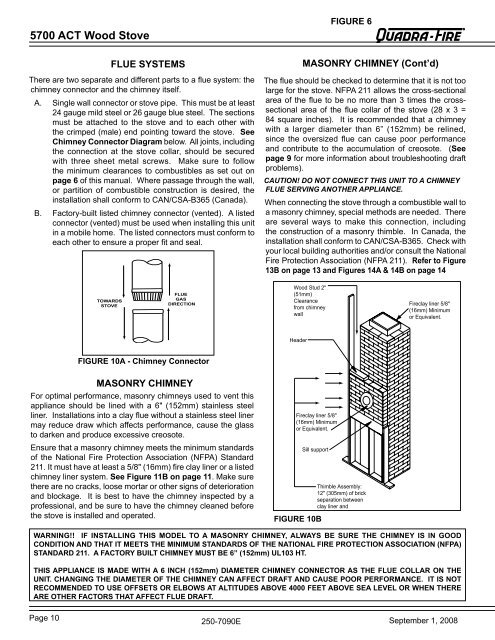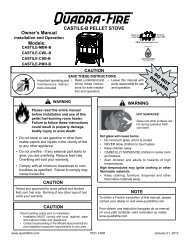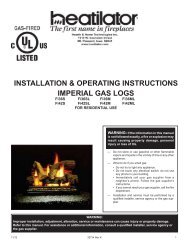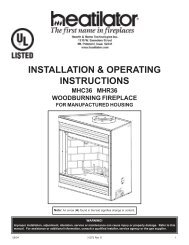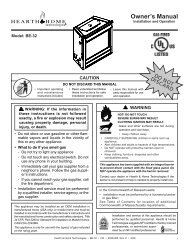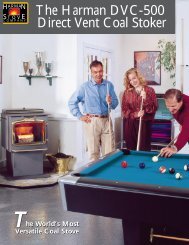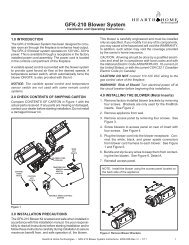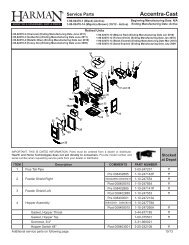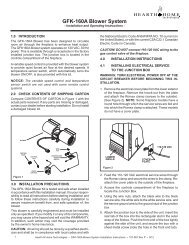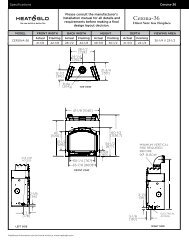5700 WOOD STOVE - Hearth & Home Technologies
5700 WOOD STOVE - Hearth & Home Technologies
5700 WOOD STOVE - Hearth & Home Technologies
- No tags were found...
You also want an ePaper? Increase the reach of your titles
YUMPU automatically turns print PDFs into web optimized ePapers that Google loves.
R<strong>5700</strong> ACT Wood Stovefigure 6FLUE SYSTEMSThere are two separate and different parts to a flue system: thechimney connector and the chimney itself.A. Single wall connector or stove pipe. This must be at least24 gauge mild steel or 26 gauge blue steel. The sectionsmust be attached to the stove and to each other withthe crimped (male) end pointing toward the stove. SeeChimney Connector Diagram below. All joints, includingthe connection at the stove collar, should be securedwith three sheet metal screws. Make sure to followthe minimum clearances to combustibles as set out onpage 6 of this manual. Where passage through the wall,or partition of combustible construction is desired, theinstallation shall conform to CAN/CSA-B365 (Canada).B. Factory-built listed chimney connector (vented). A listedconnector (vented) must be used when installing this unitin a mobile home. The listed connectors must conform toeach other to ensure a proper fit and seal.MASONRY CHIMNEY (Cont’d)The flue should be checked to determine that it is not toolarge for the stove. NFPA 211 allows the cross-sectionalarea of the flue to be no more than 3 times the crosssectionalarea of the flue collar of the stove (28 x 3 =84 square inches). It is recommended that a chimneywith a larger diameter than 6” (152mm) be relined,since the oversized flue can cause poor performanceand contribute to the accumulation of creosote. (Seepage 9 for more information about troubleshooting draftproblems).CAUTION! DO NOT CONNECT THIS UNIT TO A CHIMNEYFLUE SERVING ANOTHER APPLIANCE.When connecting the stove through a combustible wall toa masonry chimney, special methods are needed. Thereare several ways to make this connection, includingthe construction of a masonry thimble. In Canada, theinstallation shall conform to CAN/CSA-B365. Check withyour local building authorities and/or consult the NationalFire Protection Association (NFPA 211). Refer to Figure13B on page 13 and Figures 14A & 14B on page 14TOWARDS<strong>STOVE</strong>FLUEGASDIRECTIONWood Stud 2"(51mm)Clearancefrom chimneywallFireclay liner 5/8"(16mm) Minimumor equivalent.HeaderFIGURE 10A - Chimney ConnectorMASONRY CHIMNEYFor optimal performance, masonry chimneys used to vent thisappliance should be lined with a 6" (152mm) stainless steelliner. Installations into a clay flue without a stainless steel linermay reduce draw which affects performance, cause the glassto darken and produce excessive creosote.Ensure that a masonry chimney meets the minimum standardsof the National Fire Protection Association (NFPA) Standard211. It must have at least a 5/8" (16mm) fire clay liner or a listedchimney liner system. See Figure 11B on page 11. Make surethere are no cracks, loose mortar or other signs of deteriorationand blockage. It is best to have the chimney inspected by aprofessional, and be sure to have the chimney cleaned beforethe stove is installed and operated.Fireclay liner 5/8"(16mm) Minimumor equivalent.Sill supportFIGURE 10BThimble Assembly:12" (305mm) of brickseparation betweenclay liner andcombustibles.WARNING!! if installing this model to a masonry chimney, always be sure the chimney is in goodcondition and that it meets the minimum standards of the national fire protection association (NFPA)standard 211. A FACTORY BUILT CHIMNEY MUST BE 6” (152mm) UL103 HT.this appliance is made with a 6 inch (152mm) diameter chimney connector as the flue collar on theunit. changing the diameter of the chimney can affect draft and cause poor performance. it is notrecommended to use offsets or elbows at altitudes above 4000 feet above sea level or when thereare other factors that affect flue draft.Page 10250-7090ESeptember 1, 2008


